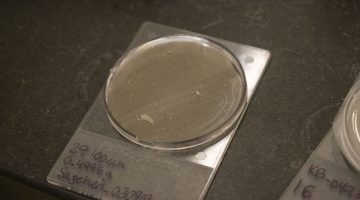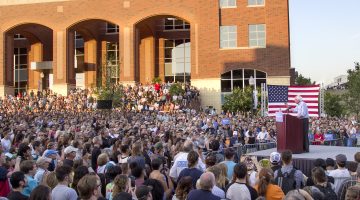
Joey Lovato/Nevada Sagebrush
Science marchers gather at Reno City Hall on Saturday, April 22, for the Northern Nevada March for Science. The Reno Police Department estimated that around 2,000 marchers attended the demonstration.
Scientists and science supporters adorned in lab coats and carrying signs flooded downtown Reno, Saturday for the Northern Nevada March for Science. Marchers took to the streets to show resistance towards President Donald J. Trump’s anti-environmental policies and budget proposals.
The Northern Nevada March for Science, along with over 600 other marches worldwide, showcased homemade signs from doctors, biologists, archaeologists, teachers, parents and their children and a diverse group of speakers.
The Reno Police Department estimated around 2,000 attended the Reno march.
As the last few stragglers of the crowd cleared the Virginia Street Bridge, they gathered into City Plaza where the marchers heard from a number of speakers.
“The science community many times has evaded participation in community activism, but not anymore,” said Sarah Mahler, chairperson for the Democratic Party of Washoe County.
Mahler emphasized her work as a doctor in veterinary medicine and as a mother before her efforts as chair, in which she facilitates the participation of Democrats in party activities and assists party members seeking public office and other positions.
“They’re just as active as any other community member,” Mahler said of the science community. “There’s a certain population that strives to remain non-partisan as a scientist, until this presidency. It’s united masses of people that otherwise would not spend a day together.”
Other demonstrators said they borrowed lab coats and drew up signs to express the importance of science. Those signs expressed the marcher’s desires to save bees, promote clean energy, encourage science education in elementary schools, political participation and scientific literacy.
On March 28, President Trump signed an executive order that scrapped six Obama era climate change policies and called for a complete review of the Clean Power Plan. The plan was essential for the U.S. to meet its goal for carbon emissions set in the landmark 2015 Paris agreement. His budget proposal to Congress calls for an 18 percent cut to the National Institutes of Health and a 31 percent cut and elimination of 3,200 EPA employees from the Environmental Protection Agency.
Ana Casareto and other community organizers held the first meeting for the Northern Nevada March for Science four days after the Trump administration ordered a media blackout at the Environmental Protection Agency, according to the Reno Gazette-Journal. Trump’s order came four days after the Jan. 20 inauguration.
“We’re standing up against fiscal cuts to the scientific endeavor,” Casareto said. “To be a science advocate, you can be anybody and you should be everybody.”
Lack of political will from Nevada representatives Dean Heller and Mark Amodei was one of the reasons several marchers gave when asked why they had chosen to show their support for science. Heller and Amodei’s names appeared on several signs on Saturday, pleading them to vote against the president’s budget proposal and other policies.
“We don’t need coal-fired power plants, we don’t even need natural gas power plants,” said Christopher Ginac, a Reno resident. “Amodei and Heller, we need to make sure that they start voting the way that Nevadans want them to vote versus what their donors want. It’s all the money and lack of political will.”
Heather Simms, a kindergarten teacher at Natchez Elementary School in Wadsworth, Nev. said she marched to promote integration of science education in the earlier years of school.
“I think in elementary schools the focus is so much on reading and math, and we really need to integrate more sciences,” said Simms.
Simms also expressed the lack of political will in Nevada as a major hurdle.
“When we have representatives up for re-election we need to make sure their focus is science,” Simms said.
One sign seemingly out of place at the march read, “No Pebble Mine, Save Bristol Bay!” The sign was carried by Jason Barnes, a biologist for Trout Unlimited, a nationwide group of scientists that protect, restore and sustain cold water trout and salmon fisheries and their watersheds.
Bristol Bay is a global wild salmon stronghold in Southwest Alaska that has supported Native Alaskans for thousands of years. Currently, it supports a $1.5 billion commercial and sport fishery.
Pebble Mine is a proposal for the largest mine in North America that would be located at the Kvichak and Nushagak rivers in Bristol Bay and is a part-time advocacy issue for Barnes.
“My big fear is that they will make permitting easier and possible,” said Barnes. “The EPA was one of the big roadblocks to permitting Pebble Mine. If they weaken the EPA than all those roadblocks to putting a bad mine in a bad place will be taken down.”
Carlos Perez-Campbell, a University of Nevada, Reno, student and president of the Washoe County Young Democrats said he marched to garner attention to climate change effects, specifically air pollution already observed in Reno.
“Reno already has one of the highest air pollution rates in the country,” Campbell said. “We often see in the dry summer months high rates of asthma and other respiratory issues.”
A report by the American Lung Association in 2016 found Reno tied for No. 11 most polluted city in America for short-term particle pollution.












